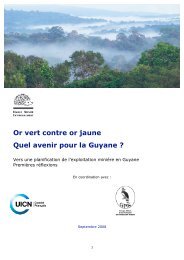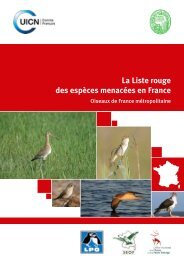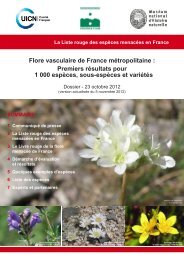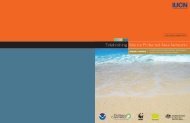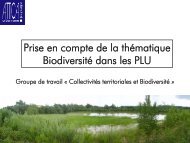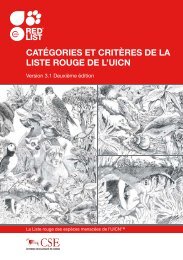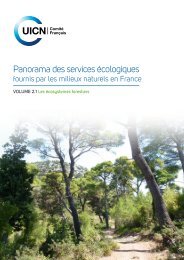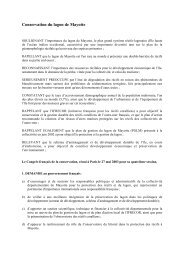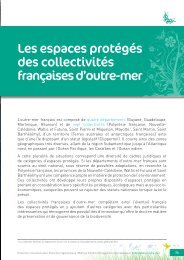Synthèse par collectivité et annexes - Especes-envahissantes ...
Synthèse par collectivité et annexes - Especes-envahissantes ...
Synthèse par collectivité et annexes - Especes-envahissantes ...
Create successful ePaper yourself
Turn your PDF publications into a flip-book with our unique Google optimized e-Paper software.
53<br />
Holway, D.A., Lach, L., Suarez, A.V., Tsutui, N.D., & Case, T.J. (2002). The causes and consequences of ant invasions. Annual Review of Ecology and<br />
Systematic 33: 181-233.<br />
54<br />
Jourdan, H., Chazeau, J., & Bonn<strong>et</strong> de Larbogne, L. (2002). The recent introduction of the neotropical tramp ant Wasmannia auropunctata (Roger)<br />
into Vanuatu Archipelago (Southwest Pacific). Sociobiology, 40 : 483-509.<br />
55<br />
Jourdan, H. (2005). Diagnostic de l’invasion de la Fourmi électrique <strong>et</strong> soutien technique au programme polynésien « Wasmannia auropunctata »,<br />
5–12 Février 2005 (Consultance Délégation à la recherche de Polynésie française). Nouméa, IRD, rapport technique, 33 p.<br />
56<br />
Pimental, D., Lach, L., Zuniga, R., & Morrison, D. (2000). Environmental and Economic costs of nonindigenous Species in the United States.<br />
Bioscience, 10 : 53-65.<br />
57<br />
Lefrancois, T., Blitvich, B.J. Pradel, J., Molia, S., Vachiery, N., & Martinez, D. (2006). West nile virus in Guadeloupe: introduction, spread, and<br />
decrease in circulation level: 2002-2005. Annals of the New York Academy of Sciences, 1081: 206-215.<br />
58 Murray, J., Murray, E., Johnson, M.S., & Clarke, B. (1988). The extinction of <strong>par</strong>tula on Moorea. Pacific Science, 42: 150-158.<br />
59<br />
Coote, T. & Loève, E. (2003) From 61 species to five: endemic tree snail of the Soci<strong>et</strong>y Islands fall prey to an ill-judged biological control<br />
programme. Oryx, 37: 91-96.<br />
60 Coote, T., Clarke, D., Loève, E., & Meyer, J.-Y. (1999). Extant population of endemic <strong>par</strong>tulids on Tahiti, French Polynesia. Orix, 33: 215-222.<br />
61<br />
Bouch<strong>et</strong>, P., Jaffre, T., & Veillon, J.M. (1995). Plant extinction in New Caledonia: protection of sclerophyll forests urgently needed. Biodiversity &<br />
Conservation, 4 : 415-428.<br />
62 Micol, T. & Jouventin, P. (1995). Restoration of Amsterdam Island, South Indian Ocean, following control of feral cattle. Biol. Conserv., 72: 199-206.<br />
63 Courchamp, F., Chapuis, J.L., & Pascal, M. (2003). Mammal invaders on islands: impact, control and control impact. Biol. Rev., 78: 347-383.<br />
64<br />
Jouventin, P., Bried, J., & Micol, T. (2003). Insular bird population can be saved from rats: a long term experimental study of Procellaria<br />
aequinoctialis on the Croz<strong>et</strong> archipelago. Polar Biology, 26: 371-378.<br />
Lorvelec, O., Delloue, X., Pascal, M., & Mege, S. (2004). Impact des mammifères allochtones sur quelques espèces autochtones de l'îl<strong>et</strong> Fajou<br />
65 (Réserve Naturelle du Grand Cul-de-Sac-Marin, Guadeloupe), établis à l'issue d'une tentative d'éradication. Revue d'Ecologie (La Terre <strong>et</strong> la Vie),<br />
59 : 293-307.<br />
Pascal, M., Brithmer, R., Lorvelec, O., & Venumière, N. (2004). Conséquences sur l'avifaune nicheuse de la réserve naturelle des îl<strong>et</strong>s de Sainte-<br />
66 Anne (Martinique) de la récente invasion du rat noir (Rattus rattus), établis à l'issue d'une tentative d'éradication. Revue d'Ecologie (La Terre <strong>et</strong> la<br />
Vie), 59, 309-318.<br />
67<br />
Holyoak, D. T. & Thibault, J. C. (1984). Contribution à l’Étude des Oiseaux de Polynésie Orientale. Mémoires du Muséum National d’Histoire<br />
Naturelle, n.s. Série A, Zoologie, Tome 127. Éditions du Museum, Paris.<br />
68<br />
Rhymer, JM., Williams, MJ., & Braun, M.J. (1994). Mitochondrial analysis of gene flow b<strong>et</strong>ween New Zealand Mallards (Anas platyrhynchos) and<br />
Grey Duck (Anas superciliosa). The Auk, 111(4) : 970-978.<br />
69<br />
Rhymer, J., Williams, MJ. Kingsford, R. (2004). Implications of phylogeography and population gen<strong>et</strong>ics for subspecies taxonomy of Grey (Pacific<br />
Duck), Anas superciliosa and its conservation in New Zealand. Pacific Conservation biology, 10 : 57-66. (2004).<br />
70 Lever C. (1987). Naturalized Birds of the World. Edition Longman Scin<strong>et</strong>ific & Technical, A., U.K. 615 p.<br />
71<br />
Meyer, J.-Y. & Florence, J. (1996). Tahiti's native flora endangered by the invasion of Miconia calvescens DC. (Melastomataceae). Journal of<br />
Biogeography, 23 : 775-781.<br />
72 Meyer, J.-Y. (2004). Threat of invasive alien plants to native flora and forest veg<strong>et</strong>ation of eastern Polynesia. Pacific Science, 58 : 357-375.<br />
73<br />
Atkinson, I.A.E. (1985). The spread of commensal species of Rattus to oceanic islands and their effects on island avifaunas. ICPB Technical<br />
publication, 3: 35-81.<br />
Meyer, J.-Y., & Butaud, J.F. (2007). Rats as transformers of native forests in the islands of French Polynesia (South Pacific). In Rats, Humans, and<br />
74 their impacts on islands: integrating historical and contempory ecology. University of Hawai’i. Conference 27-31 March 2007. Communication<br />
orale.<br />
75<br />
Brescia, F., de Garine Wichatitsky, M., Potter, M., & Papineau, C. (2007). Impacts of invasive rodents on native fauna and flora of New Calédonia. In<br />
Rats, Humans, and their impacts on islands: integrating historical and contempory ecology. University of Hawai’i. Conference 27-31 March 2007.<br />
Butaud, J.F., & Raharivelomana, P. (2007). Rat impacts on the recruitment of the endangered endemic sandalwood (Santalum insulare) in French<br />
76 Polynesia. In Rats, Humans, and their impacts on islands : integrating historical and contempory ecology. University of Hawai’i. Conference 27-31<br />
March 2007.<br />
77<br />
Jourdan, H., Sablier, R., & Bauer, A. (2001). Little fire ant invasion (Wasmannia auropunctata) as a threat to New Caledonian lizards: evidences<br />
from a sclerophyll forest (Hymenoptera: Formicidae). Sociobiology, 38, 283-301.<br />
78<br />
Jourdan, H., Sadlier, R., & Bauer, A. (2001). The impact of the little fire ant invasion Wasmannia auropunctata (Roger) on the New Caledonian<br />
herp<strong>et</strong>ofauna: results of a study in sclerophyll forest habitat. Sociobiology, 38: 1-19.<br />
Jourdan, H., & Dumas, P. (2003). Les espèces animales invasives dans le Pacifique : l'apport de la spatialisation dans le cas de la fourmi<br />
79 envahissante Wasmannia auropuctata. In : David Gilbert (dir.). Espaces tropicaux <strong>et</strong> risques : du local au global : actes des 10èmes journées de<br />
géographie tropicale des 24, 25 <strong>et</strong> 26 septembre 2003. Orléans (FRA).<br />
80<br />
Chazeau, J., Jourdan, H., & Le Br<strong>et</strong>on, J. (2002). Etude de l'invasion de la Nouvelle Calédonie <strong>par</strong> la fourmi pionnières Wasmannia auropunctata :<br />
modalités, impact sur la biodiversité, moyens d'une maîtrise de la nuisance. IRD, Nouméa, Nouvelle Calédonie.<br />
173



